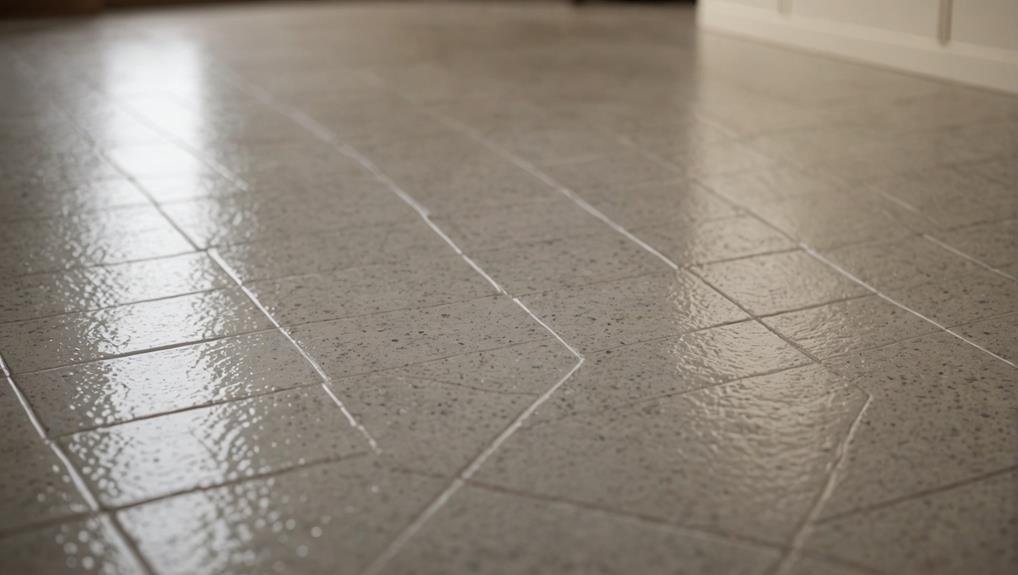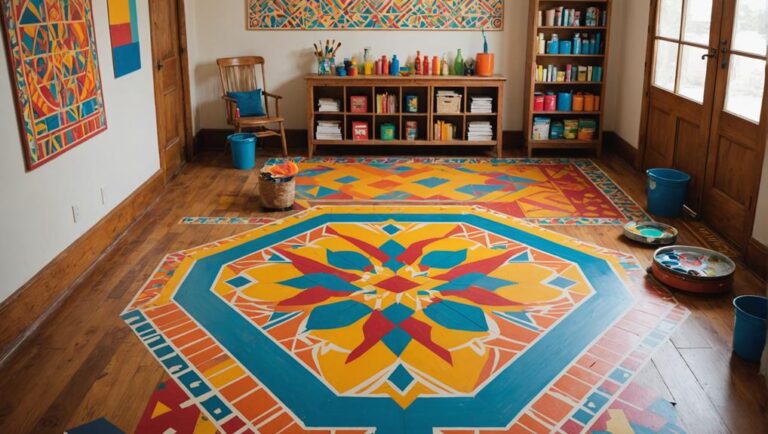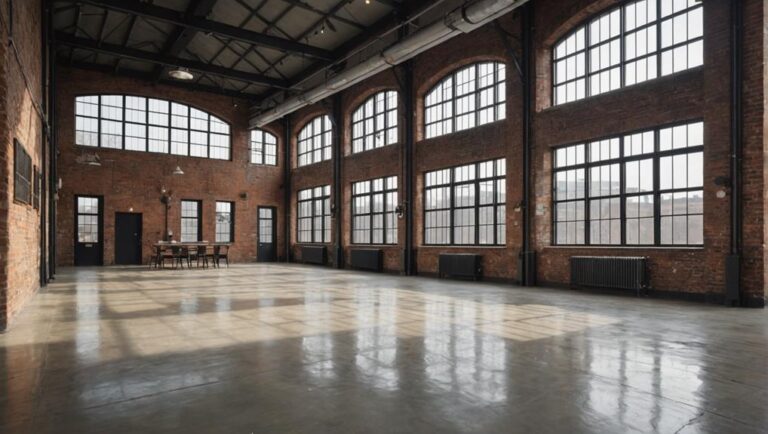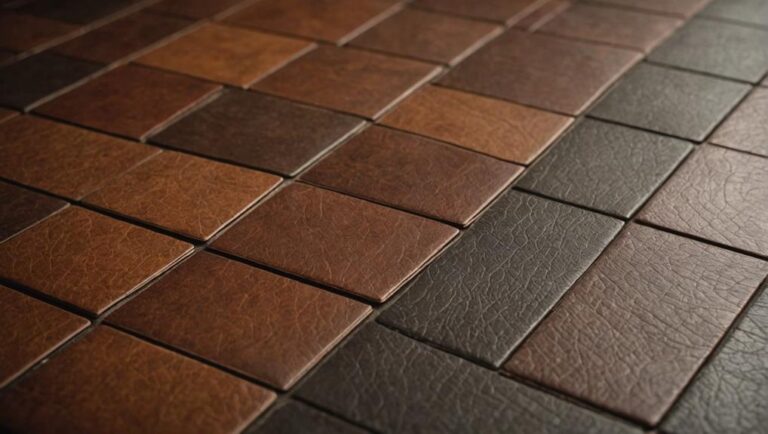Anti-slip coatings are essential for tile and stone floors, boosting safety by improving traction and lowering the risk of slips and falls, especially in high-traffic areas. You'll find various types, including epoxy and polyurethane coatings, each offering unique benefits. These coatings work by altering the surface texture to enhance grip and channel moisture away. The application process is straightforward, perfect for both professionals and DIYers. Regular maintenance guarantees longevity, while cost considerations reflect the initial investment against potential savings from reduced accidents. Discovering the right product for your situation can make all the difference in guaranteeing safety.
Importance of Anti-Slip Coatings
In today's world, guaranteeing safety in both residential and commercial spaces is more vital than ever. One of the key components in achieving this is the implementation of anti-slip coatings on tile and stone floors. These coatings play an essential role in preventing slips and falls, which are among the leading causes of injury in various environments.
When you consider safety standards, anti-slip coatings greatly enhance traction on surfaces that might otherwise be dangerously slick, especially in high-traffic areas. By applying these coatings, you're not only complying with safety regulations but also fostering a safer environment for everyone. This is particularly important in settings like restaurants, hospitals, and homes with children or elderly individuals.
Moreover, the application of anti-slip coatings doesn't compromise floor aesthetics. Many modern formulations are designed to maintain the visual appeal of your flooring while providing superior slip resistance. You'll find options that blend seamlessly with various tile and stone finishes, allowing you to prioritize safety without sacrificing style.
Investing in anti-slip coatings is a proactive measure that can save lives and reduce liability risks. Whether you're renovating your home or managing a commercial property, understanding the importance of these coatings guarantees that you're making informed decisions that align with safety standards and floor aesthetics. Ultimately, enhancing traction and safety can lead to a more secure environment for everyone who walks through your space.
Types of Anti-Slip Coatings
When considering anti-slip coatings, you'll encounter two primary types: epoxy-based and polyurethane coatings. Each offers distinct advantages regarding durability and slip resistance. Understanding these differences can help you choose the right solution for your tile or stone flooring needs.
Epoxy-Based Coatings
Epoxy-based coatings are a popular choice for enhancing the slip resistance of tile and stone floors. These coatings utilize unique epoxy properties that provide a strong, adhesive bond to the surface, ensuring a long-lasting application. One of the key benefits of epoxy coatings is their exceptional surface durability, which withstands heavy foot traffic and various environmental conditions without deteriorating.
When applied correctly, epoxy coatings create a textured surface that noticeably improves traction, reducing the risk of slips and falls. This is particularly important in areas prone to moisture, where traditional flooring can become dangerously slick. Additionally, epoxy coatings are resistant to chemicals and stains, making them ideal for commercial settings like kitchens and bathrooms.
You'll find that the application process is relatively straightforward, often involving a primer followed by multiple layers of epoxy. It's essential to allow adequate curing time to achieve ideal performance. By selecting epoxy-based coatings, you're not only enhancing safety but also investing in a solution that provides lasting protection for your tile and stone floors. Ultimately, this choice supports a safer environment, ensuring peace of mind for you and your visitors.
Polyurethane Coatings
Polyurethane coatings are frequently chosen for their impressive versatility and effectiveness in providing anti-slip properties to tile and stone floors. These coatings enhance surface safety by creating a textured finish that considerably reduces slip hazards, especially in wet environments. One of the standout features of polyurethane is its durability; it withstands heavy foot traffic and resists wear, ensuring long-lasting performance.
When considering polyurethane application, you'll find that it's relatively straightforward, making it suitable for both professional contractors and DIY enthusiasts. Typically, the surface must be cleaned and primed before applying the coating, which can be rolled or sprayed on for even coverage. Once cured, polyurethane forms a strong bond with the substrate, enhancing both safety and aesthetic appeal.
Additionally, polyurethane coatings are available in various finishes, allowing you to choose the right look for your space while maintaining anti-slip properties. Whether you're looking to protect a commercial area or a residential space, these coatings can provide the safety and durability you need. Investing in polyurethane coatings can considerably reduce slip-and-fall accidents, ensuring a safer environment for everyone.
Benefits of Using Anti-Slip Coatings
Using anti-slip coatings on tile and stone floors can considerably enhance safety in both residential and commercial environments. These coatings not only improve traction but also contribute to compliance with safety regulations, making your space safer for everyone. By applying anti-slip coatings, you're taking a proactive step toward preventing slips and falls, which are common hazards associated with various flooring materials.
Here are three key benefits of using anti-slip coatings:
- Enhanced Safety: One of the primary reasons to use anti-slip coatings is to reduce the risk of accidents. Improved grip on slippery surfaces helps prevent falls, especially in areas prone to moisture, such as kitchens and bathrooms.
- Versatility: Anti-slip coatings can be applied to various flooring materials, including tiles, stones, and even concrete. This versatility allows you to enhance safety in both indoor and outdoor environments without needing to replace existing flooring.
- Cost-Effective Solution: Implementing anti-slip coatings is often more economical than replacing flooring materials. You can achieve significant safety improvements with a relatively low investment, which also helps in compliance with safety regulations that may apply to your space.
How Anti-Slip Coatings Work
Anti-slip coatings enhance floor safety by altering the surface texture, which increases friction. You'll find various types of coatings designed for specific environments, each with unique mechanisms of action. Understanding these factors is essential for selecting the right solution for your tile or stone floors.
Mechanism of Action
Often overlooked, the mechanism of action for anti-slip coatings relies on enhancing the surface texture of tiles and stone floors. By modifying the surface properties, these coatings increase friction enhancement, considerably reducing the risk of slips and falls. Here's how they work:
- Surface Roughening: The application of anti-slip coatings creates microscopic textures on the floor's surface, which helps grip footwear better.
- Increased Contact Area: By increasing the surface area that contacts your shoe, these coatings improve traction, making it harder to slip.
- Water Displacement: Many coatings are designed to channel away moisture, minimizing the slippery effects of water on the floor.
When you apply an anti-slip coating, you're not just adding a layer; you're fundamentally altering the interaction between the floor and footwear. This enhanced surface texture is essential for providing the friction enhancement necessary for safety. Whether in homes, businesses, or public areas, understanding this mechanism guarantees you make informed decisions about your flooring safety. Remember, a safer surface can prevent accidents and protect everyone who walks on it.
Types of Coatings
A variety of coatings are available to enhance the slip resistance of tile and stone floors, each designed to cater to specific needs and environments. These coatings typically fall into three categories: topical, penetrating, and texture-based.
Topical coatings create a protective layer on the surface, enhancing grip while maintaining the original appearance of the flooring. Their coating durability is often high, but regular maintenance may be necessary to guarantee effectiveness.
Penetrating coatings, on the other hand, work by infiltrating the material's surface, modifying its properties to improve slip resistance. These coatings can provide a long-lasting solution, as they bond with the substrate and adjust the surface texture without altering the floor's aesthetic.
Texture-based solutions involve adding a rougher finish to the floor, which physically increases friction and reduces slip potential. This method can be particularly effective in high-traffic areas or environments prone to moisture.
When selecting an anti-slip coating, consider factors such as the desired surface texture, coating durability, and the specific environment where the coating will be applied to guarantee peak safety and performance.
Application Process Overview
Before applying anti-slip coatings to tile and stone floors, it's vital to prepare the surface properly to guarantee maximum adhesion and effectiveness. This step is essential to make sure that the coating performs at its best and provides the safety you need. Here's a concise overview of the application process.
- Clean the Surface: Begin by thoroughly cleaning the floor to remove dirt, grease, and any existing sealers. Use a suitable cleaner and a scrub brush, and rinse well with water. Allow the surface to dry completely.
- Inspect for Damage: Check for any cracks or chips in the tile or stone. Repair any damage before proceeding, as these imperfections can compromise the coating's effectiveness.
- Choose Application Techniques: Depending on the product you're using, select appropriate application techniques. This may involve using a roller, brush, or spray, making sure of even coverage. Follow the manufacturer's guidelines on application thickness and drying times.
Once you've completed these steps, you're ready to apply the anti-slip coating. Remember, proper surface preparation is key to achieving a durable and effective anti-slip finish. Neglecting these steps can lead to premature wear and reduced performance, posing potential safety hazards. By following this overview, you can create a safer, slip-resistant environment in your space.
Choosing the Right Product
How do you determine which anti-slip coating is best for your tile or stone floors? You'll need to take into account several key factors, primarily focusing on product durability and surface compatibility. First, evaluate the durability of the coating. A product that withstands wear and tear will not only maintain its effectiveness but also save you from frequent reapplications. Look for coatings that offer long-lasting performance, especially in high-traffic areas.
Next, assess surface compatibility. Different coatings are formulated for specific types of tiles and stones. Verify the product you choose is suitable for your flooring material, as incompatibility can lead to ineffective slip resistance or damage to the surface. Check manufacturer specifications and guidelines to confirm that the coating will adhere appropriately and perform as intended.
Additionally, take into account the environmental conditions your floors are exposed to. If your space is prone to moisture, select a coating designed to resist water penetration and mold growth. For outdoor areas, a UV-resistant product may be necessary to prevent degradation from sunlight.
Lastly, think about the application process and the finish you desire. Some coatings provide a glossy finish, while others offer a more matte appearance. Choose one that aligns with your aesthetic preferences while still prioritizing safety.
Maintenance of Anti-Slip Coatings
Maintaining anti-slip coatings is essential to guarantee their longevity and effectiveness on your tile or stone floors. Regular maintenance not only preserves the coating's anti-slip properties but also enhances the overall safety of your space. Here are some key practices to promote peak performance:
- Regular Cleaning: Use a pH-neutral cleaner to avoid degrading the coating. Harsh chemicals can compromise the surface preparation and effectiveness of the anti-slip treatment. Mop the floors regularly to remove dirt and grime that can diminish traction.
- Periodic Inspections: Check the surface for signs of wear, such as peeling or discoloration. If you notice any deterioration, it may be time to reapply the coating. Addressing issues early helps maintain coating longevity and prevents slips and falls caused by compromised surfaces.
- Avoid Excessive Moisture: Make certain that spills are cleaned up promptly to prevent moisture buildup, which can lead to slippery conditions. Additionally, avoid using wax or polish on anti-slip coatings, as these can create a slick surface that defeats the purpose of your safety measures.
Common Misconceptions
Anti-slip coatings are often surrounded by misconceptions that can lead to improper application and maintenance. One common myth is that all anti-slip coatings are the same. In reality, different coatings are designed for specific surfaces and environments. Understanding these distinctions is vital for meeting safety standards. Selecting an inappropriate product may not only fail to enhance safety but could also result in damage to the flooring.
Another misconception is that anti-slip coatings are a one-time solution. Regular maintenance is essential to guarantee their effectiveness. Myth debunking reveals that wear and tear, environmental factors, and cleaning practices can diminish the coating's performance over time. As a result, routine inspections and reapplications are necessary to maintain peak safety levels.
Some people believe that anti-slip coatings alter the appearance of their floors. While some coatings might slightly change the surface's texture, many modern formulations are designed to be nearly invisible while providing enhanced grip. This guarantees that aesthetics are preserved without compromising safety.
Lastly, there's a belief that applying an anti-slip coating will make floors excessively rough or abrasive. In reality, high-quality coatings are engineered to provide safe traction without creating discomfort or damaging footwear. By addressing these misconceptions, you can make informed decisions that prioritize safety and compliance with industry standards. Ultimately, investing in the right anti-slip solution can protect against slips and falls, creating a safer environment for everyone.
Cost Considerations
While investing in anti-slip coatings can greatly enhance safety, it is vital to evaluate the associated costs and long-term value. Understanding the financial implications will help you make an informed decision for your home or business. Here are some key cost considerations:
- Installation Costs: The initial expense of applying anti-slip coatings varies based on the type of coating and the size of the area. Generally, you can expect to pay anywhere from $1 to $3 per square foot. It's important to get quotes from multiple contractors to guarantee competitive pricing.
- Maintenance Requirements: Some coatings require periodic reapplication or maintenance to maintain their effectiveness. Factor in these additional costs when budgeting. Regular upkeep can help extend the lifespan of the coating, ultimately bringing long-term savings.
- Insurance Discounts: Installing anti-slip coatings may qualify you for discounts on your liability insurance. By reducing the risk of slips and falls, insurers often recognize the investment as a proactive safety measure.
When you assess these factors, you'll see that while there are upfront installation costs, the long-term savings can outweigh them. Enhanced safety not only protects your loved ones but also lowers potential medical costs from accidents. Ultimately, investing in anti-slip coatings is a prudent decision that prioritizes safety and financial prudence.
Frequently Asked Questions
Can Anti-Slip Coatings Be Applied Outdoors?
Yes, anti-slip coatings can be applied to outdoor surfaces. They're specifically designed to withstand environmental factors like rain, snow, and UV exposure. When you choose the right coating, you're enhancing safety, improving traction, and reducing slip hazards. It's vital to verify the product is suitable for outdoor use, as this guarantees durability and effectiveness. By prioritizing safety on outdoor surfaces, you create a secure environment for everyone, irrespective of weather conditions.
How Long Do Anti-Slip Coatings Last?
The longevity of coatings largely depends on factors like coating durability and maintenance requirements. Generally, high-quality coatings can last several years, but regular upkeep is essential to maximize their lifespan. If you follow the manufacturer's guidelines and maintain a clean surface, you can expect peak performance. Environmental conditions, foot traffic, and cleaning practices can also impact how long your coating remains effective, so it's vital to monitor its condition periodically.
Are Anti-Slip Coatings Safe for Pets?
Did you know that about 50% of pet owners worry about their pets' safety on slippery surfaces? When considering anti-slip coatings, you'll be pleased to know they're generally safe for pets. These coatings enhance the surface texture, providing better grip for your furry friends. Just verify the product is non-toxic and specifically designed for indoor use, as this will help protect your pets while maintaining a safe and secure environment for them to roam.
Will Anti-Slip Coatings Change the Tile Appearance?
When applying a coating, it's common to wonder if it'll change the tile's appearance. Generally, anti-slip coatings can slightly alter the tile texture and add a gloss finish. This gloss may enhance the look, but the original color and pattern often remain visible. Make certain you choose a coating designed for your specific tile type to minimize any unwanted changes and maintain safety without compromising aesthetic appeal. Always test a small area first.
Can I Apply Anti-Slip Coatings Myself?
Yes, you can apply anti-slip coatings yourself with a DIY application, but it's vital to choose the right coating types for your surface. Make sure you follow manufacturer instructions carefully for maximum safety and effectiveness. Proper surface preparation is essential, and you'll need to use the appropriate tools. While it's feasible, consider your skill level and the specific requirements of the coating to achieve the best results and maintain safety in your environment.




